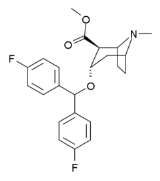
Difluoropine
Encyclopedia
-(+)-2β-Carbomethoxy-3α-(bis(4-fluorophenyl)methoxy)tropane (Difluoropine, O-620) is a stimulant
drug synthesised from tropinone
, which acts as a potent and selective dopamine reuptake inhibitor
. Difluoropine is unique among the tropane-derived dopamine reuptake inhibitors in that the active stereoisomer is the (S) enantiomer rather than the (R) enantiomer, the opposite way round compared to natural cocaine
. It is structurally related to benztropine
and has similar anticholinergic
and antihistamine
effects in addition to its dopamine reuptake inhibitory action.
Difluoropine has some stimulant effects in animals, although it is significantly less powerful than many of the potent phenyltropane
derived stimulant drugs such as WIN 35,428 and RTI-55. It showed promising effects in alleviating the symptoms of Parkinson's Disease
in an animal model of the disorder.
It is not explicitly illegal anywhere in the world , but might be considered to be a controlled substance analogue
of cocaine on the grounds of its related chemical structure, in some jurisdictions such as the USA, Canada
, Australia
and New Zealand
.
Stimulant
Stimulants are psychoactive drugs which induce temporary improvements in either mental or physical function or both. Examples of these kinds of effects may include enhanced alertness, wakefulness, and locomotion, among others...
drug synthesised from tropinone
Tropinone
Tropinone is an alkaloid, famously synthesised in 1917 by Robert Robinson as a synthetic precursor to atropine, a scarce commodity during World War I. Tropinone and the alkaloids cocaine and atropine all share the same tropane core structure.-Synthesis:...
, which acts as a potent and selective dopamine reuptake inhibitor
Dopamine reuptake inhibitor
A dopamine reuptake inhibitor is a type of drug that acts as a reuptake inhibitor for the neurotransmitter dopamine by blocking the action of the dopamine transporter...
. Difluoropine is unique among the tropane-derived dopamine reuptake inhibitors in that the active stereoisomer is the (S) enantiomer rather than the (R) enantiomer, the opposite way round compared to natural cocaine
Cocaine
Cocaine is a crystalline tropane alkaloid that is obtained from the leaves of the coca plant. The name comes from "coca" in addition to the alkaloid suffix -ine, forming cocaine. It is a stimulant of the central nervous system, an appetite suppressant, and a topical anesthetic...
. It is structurally related to benztropine
Benztropine
Benzatropine , also known as benztropine , is an anticholinergic marketed under the trade name Cogentin which is used in the treatment of Parkinson's disease, parkinsonism, akathisia, and dystonia.- Indications :...
and has similar anticholinergic
Anticholinergic
An anticholinergic agent is a substance that blocks the neurotransmitter acetylcholine in the central and the peripheral nervous system. An example of an anticholinergic is dicycloverine, and the classic example is atropine....
and antihistamine
Antihistamine
An H1 antagonist is a histamine antagonist of the H1 receptor that serves to reduce or eliminate effects mediated by histamine, an endogenous chemical mediator released during allergic reactions...
effects in addition to its dopamine reuptake inhibitory action.
Difluoropine has some stimulant effects in animals, although it is significantly less powerful than many of the potent phenyltropane
Phenyltropane
Phenyltropanes were originally developed to reduce cocaine addiction and dependency. In general these compounds act as inhibitors of the plasmalemmal monoamine reuptake transporters. Although RTI holds a strong position in this field, they are not the only researchers that have prepared these...
derived stimulant drugs such as WIN 35,428 and RTI-55. It showed promising effects in alleviating the symptoms of Parkinson's Disease
Parkinson's disease
Parkinson's disease is a degenerative disorder of the central nervous system...
in an animal model of the disorder.
It is not explicitly illegal anywhere in the world , but might be considered to be a controlled substance analogue
Federal Analog Act
The Federal Analog Act, , is a controversial section of the United States Controlled Substances Act which allowed any chemical "substantially similar" to a controlled substance listed in Schedule I or II to be treated as if it were also listed in those schedules, but only if intended for human...
of cocaine on the grounds of its related chemical structure, in some jurisdictions such as the USA, Canada
Canada
Canada is a North American country consisting of ten provinces and three territories. Located in the northern part of the continent, it extends from the Atlantic Ocean in the east to the Pacific Ocean in the west, and northward into the Arctic Ocean...
, Australia
Australia
Australia , officially the Commonwealth of Australia, is a country in the Southern Hemisphere comprising the mainland of the Australian continent, the island of Tasmania, and numerous smaller islands in the Indian and Pacific Oceans. It is the world's sixth-largest country by total area...
and New Zealand
New Zealand
New Zealand is an island country in the south-western Pacific Ocean comprising two main landmasses and numerous smaller islands. The country is situated some east of Australia across the Tasman Sea, and roughly south of the Pacific island nations of New Caledonia, Fiji, and Tonga...
.

